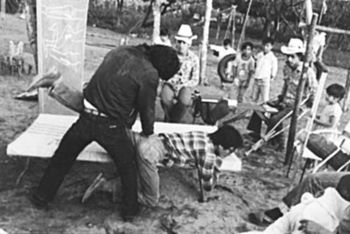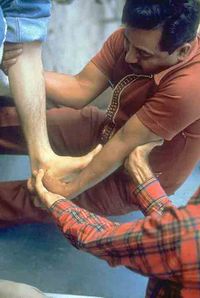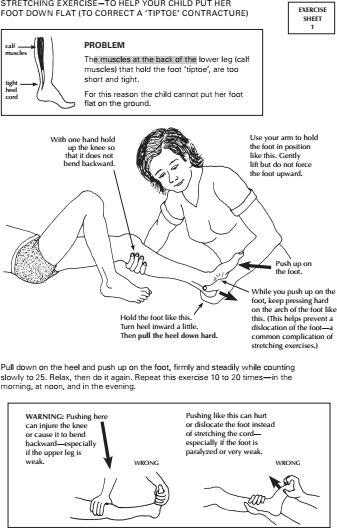Hesperian Health Guides
Chapter 2: Ideas for Sharing Information From This Book
Also, learning from a book is often not the best way to learn something. A lot of methods, aids, and exercises can be learned more easily from other persons, through watching and through guided practice. But after a village worker has taught parents how to do certain exercises, or shown them an example of a homemade aid, printed instruction sheets with clear drawings can be a big help. Sometimes they can make the difference between whether the recommendations are followed at home, or not.
There are certain pages or parts of this book that you may want to give to families after you explain and teach to them selected exercises or activities. For example, to the family of a girl with arthritis, you may want to give some of the “Exercise Instruction Sheets”, and the “Medicines for Pain” information. You may also want to give them pages on arthritis, and to mark the exercises and activities that are important to their child.
To the family of a young child with developmental delays, you may want to give pages from the chapters on child development and early stimulation activities (Chapter 34 and Chapter 35). For a more advanced child you could give the family material from the chapters on self-care (Chapters 36 to 39).
Depending on the interest and reading ability of the family, you may want to give them a whole chapter (or chapters) about their child’s disability. For example, the chapters on cerebral palsy (Chapter 9) or hearing loss (Chapter 31). An older child with paralysis from a back injury might appreciate having a copy of the chapter on spinal cord injury. Letting him and his family take home the chapters on pressure sores and urine and bowel control could even save his life! His family may also want to take home plans for making a low-cost wheelchair, to see if the carpenter and blacksmith in their village could make one.

In Project PROJIMO in Mexico, the village rehabilitation team keeps a big file box with copies of the different pages and chapters that they have found most useful for giving to families. (In fact, the exercise sheets at the end of Chapter 42 were originally prepared separately to give to families. Later, we decided to include them in this book.)
If you have a computer and internet access, you can freely download and print pages you need from our website: www.hesperian.org.
Marking the information that applies to the child
On any page or chapter that you give to parents, some of the information or suggestions will apply more than others to their child.
We suggest that you circle the activities or suggestions that would be most helpful to the child in his present condition or level of development. You could also put an “X” through anything that should not be done or might be harmful for that child.
Here is an example. If the child has spasticity and is beginning to sit, the first 3 activities in "Activities for Body Control, Balance, and Sitting" can help her to improve balance and to develop controlled body movement. So circle these. The next 3 activities will still be too difficult and could increase spasticity. Put an “X” through these so the family does not do them.

Tilting him causes him to use his body to keep his balance, which is a more advanced skill.
Making copies of pages can be costly. Or you may have to go a long way for them. Also, there will be times when you want to give a family written suggestions or drawings that you have not copied in advance.

Perhaps some of the children or young people who are at the village center, either for rehabilitation or as learners-and-workers, can help trace drawings from the book. If they have some artistic skill, they can make the drawings larger, or make the child in the drawing look like the child that they are to be used with. Ideas for drawing and for copying drawings at larger size are in Helping Health Workers Learn.
If someone prepares a set of large drawings in advance, perhaps a child with disabilities who visits the village center can trace the drawings of exercises he needs to do at home. Giving the child this responsibility from the start makes it more likely that he will do the exercises at home.
If you make your own ‘hand out’ sheets (instead of just copying pages of this book) you can use the local language and villagers’ way of saying things. You can also adapt the drawings to the hair style and dress that people feel ‘at home’ with. Whatever you do, try to keep both your language and drawings simple and clear. Avoid unfamiliar words.
Also, try to think of ways of adapting exercises or activities to the local situation.
| For example, suppose you live in a fishing village, and want to make copies of a drawing showing an aid for strengthening the wrist. Instead of just copying a method like this from a book, | you might add a drawing like this one. This will encourage parents to think of ways to do exercises that involve their child in the life and action of their community. |
 bamboo handle
flexible pole
bag of rocks |
I've got one too!
Good boy! Pull hard! |
| Fishing with father is good for the wrists, and good for the whole child. |
Remember: Written pages and drawings can be a big help, but they should not be a substitute for teaching and showing. To help a family understand activities or exercises that are needed:
- First show and explain.
- Guide them in doing it until they do it right and understand why.
- Then, give them the instruction sheet and explain the main points.
These steps are explained with examples and drawings.
As much as you can, try not to use this book for giving exact instructions on how to do things. Instead, encourage everyone to use it as a source of ideas, in order to figure out better ways to help their children lead fuller lives and manage better in their communities.
REMEMBER. . .
One of the best ways to share information from this book is to:
| 1. SHOW other people how to do things. |
| Village rehabilitation workers and family members learn in an outdoor class. Here they practice a hip-stretching exercise. Behind them, drawings on the blackboard show which muscles arestretched. |  |
| 2. Then help them LEARN BY DOING it themselves — under your guidance. | |
| Teaching a village health worker how to stretch a tight heel cord |  |
| 3. And to help them remember, give them a DRAWING or INSTRUCTION SHEET. | |




